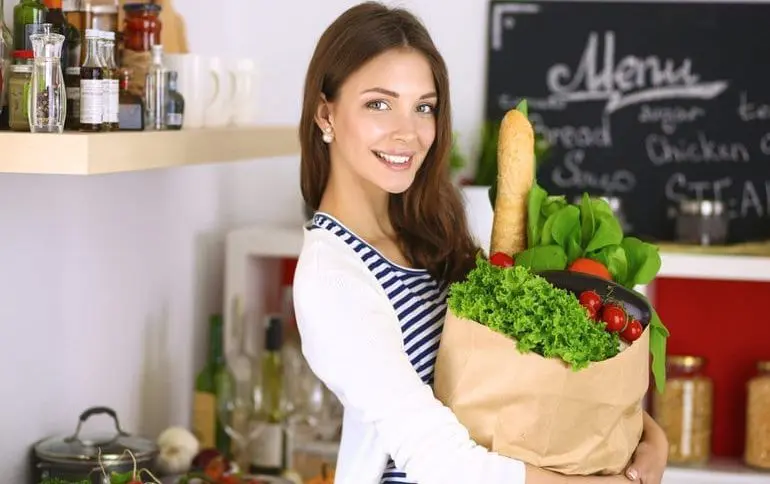What’s on your mind when you think of protein?
Typically, meat, fish, or dairy are thought to be the best protein foods, but there is, however, one overlooked food group that doesn’t get the recognition it deserves, and that’s “high protein vegetables”.
You might say, “What? Vegetables?”
Believe it or not, the overall plant-based protein package is better than the animal protein package because plants contain almost zero bad fats and cholesterol.
Thanks to their impressive nutritional profile, what Eric Edmeades, author of Mindvalley’s WILDFIT Quest, said is true, “Fruits and vegetables do not fight disease; it is their absence that causes it.”
Despite that, many believe that protein-rich vegetables can’t compete with meat in terms of the amount and quality of protein.
It’s true that most vegetables don’t have as much protein as meat but they offer a wealth of nutrients you can’t find in animal products like fiber and vitamin C.
Not sure what vegetables have protein and how much protein they offer?
Don’t sweat it, there are plenty of vegetables high in protein in the market, and we’ve listed the best 13 for you to refer to.
- Lima Beans
- Broccoli
- Spinach
- Green Peas
- Asparagus
- Edamame
- Tempeh
- Tofu
- Black Beans
- Artichoke
- Fava beans
- Kale
- Okra
But before we go through them, let’s first cover the basic question of why you need protein in the first place.
Why Do You Need Protein?
Protein is referred to as the building block of our cells because of its critical role in growing, repairing, and maintaining our muscles, tissues, and organs.
It’s also worth noting that protein plays an important role in keeping us safe and healthy in a number of ways.
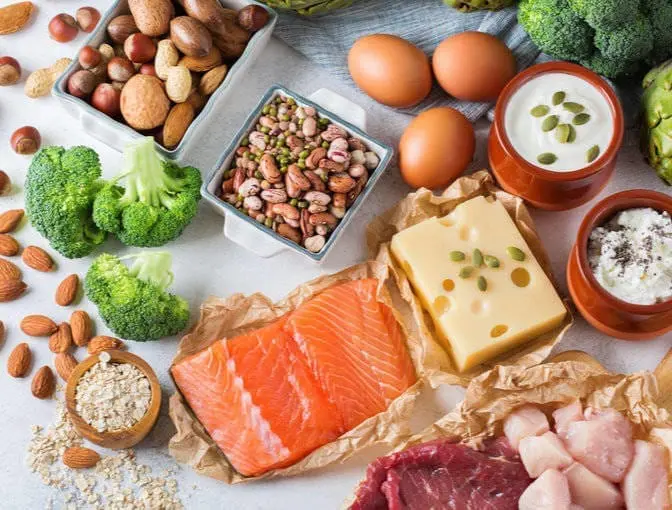
Without protein, our bodies won’t produce enough antibodies to fight off diseases, enzymes to break down foods, and structural components to keep our muscles strong.
Thankfully, most of us are getting enough protein, but chances are, we’re not getting it from healthy sources.
What Is the Best Source of Protein?
Your health is far more determined by getting in the good stuff (nutrients) than cutting out the bad stuff.
— Eric Edmeades, trainer of Mindvalley’s WILDFIT Quest
All the whole foods we eat — chicken, vegetables, fruits, and eggs — contain protein. It’s just a matter of concentration.
Foods that are high in protein, for example, are chicken breast, eggs, fish, turkey breast, and some high protein vegetables.
However, do eat with control.
Do not overeat meat because although they’re high in protein, it’s also high in saturated fat, which has been proven to increase the risks of heart disease and obesity.
Do not eat too many vegetables as well. Due to their high fiber content, you may experience bloating, stomach cramps, dehydration, or nausea.
Are vegetables a good source of protein?
We know fruits and vegetables are generally good for us, but what we don’t know is that vegetables can be a good source of protein too.
For example, a cup of broccoli contains 5.7g of protein. That’s 11% of your daily protein needs!
Other high protein vegetables are listed below but there’s another plus point to them.
The reason why vegetables are a better protein source compared to meat is because of their protein package.
Vegetables are high in nutrients, vitamins, and minerals, and low in bad fats, calories, and cholesterol.
Which Vegetables Are Rich In Protein?
Fruits and vegetables do not fight disease; it is their absence that causes it.
— Eric Edmeades, trainer of Mindvalley’s WILDFIT Quest
Here we’ve curated a list of the 13 protein-rich vegetables, their nutrition, benefits, and some healthy recipes to get you rolling.
Along the way, you will notice a word called “Daily Value” or in short, “DV”. It means the number of nutrients you need daily.
According to the U.S. Dietary Guideline 2015-2020, the protein DV is 56g for men and 46g for women.
Disclaimer: The DV in this article has been averaged for general use and is not to be used as a strict measurement.
1. Lima Beans
1 cup (180g) of boiled lima beans has:
- Calories: 189
- Protein: 12g (24% of Daily Value, DV)
- Carbohydrates: 35g (12% DV)
- Fiber: 8.6g (35% DV)
- Sugars: 2.5g (5% DV)
- Fat: 0.5g (1% DV)
- Sodium: 52.2mg (2% DV)
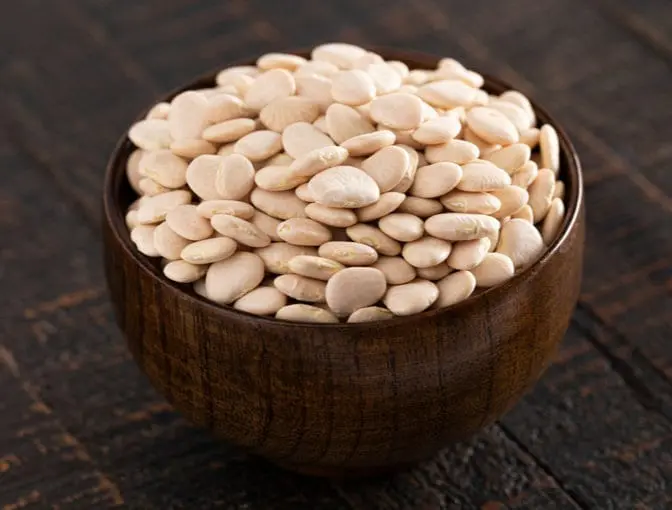
Lima beans are one of the vegetables high in protein, low in calories, low in fat, and are full of healthy starch, which can provide quick energy to your body.
Besides protein, lima beans are also high in folate, iron, potassium, magnesium, manganese, vitamin C, E, and K.
Recipes:
2. Broccoli
1 cup (184g) of boiled broccoli contains:
- Calories: 52
- Protein: 5.7g (11% DV)
- Carbohydrates: 9.8g (3% DV)
- Fiber: 5.5g (22% DV)
- Sugars: 2.7g (5% DV)
- Fat: 0.2g (0% DV)
- Sodium: 20.2mg (1% DV)
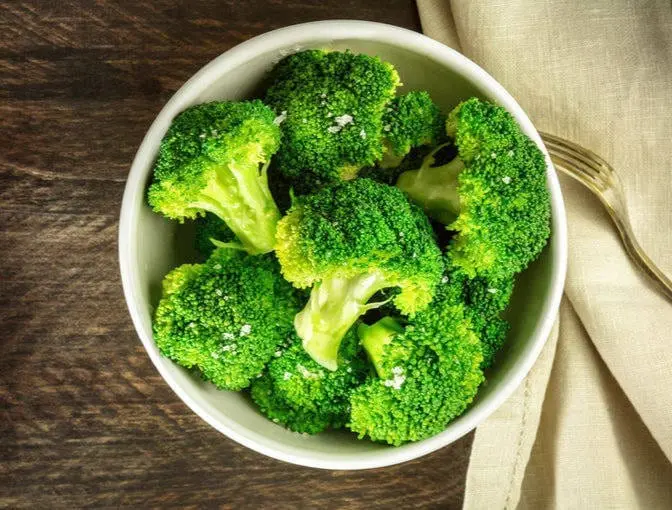
Broccoli is one of the protein-rich vegetables that are high in fiber, vitamin A, E, K and C, folate, potassium, and magnesium.
Surprisingly, a cup of broccoli provides 82% DV of vitamin C and 135% DV of vitamin K.
Broccoli also contains potent antioxidants that can benefit human health. The glucoraphanin in broccoli may offer multiple health benefits including reduced blood sugar, stress, cholesterol levels, and chronic disease development.
Recipes:
Note: You can eat broccoli cooked or raw. According to the WildFit preferred cooking method, raw foods hold the most nutrients. So eat them raw if you can.
3. Spinach
1 cup (180g) of cooked spinach holds:
- Calories: 41
- Protein: 5.3g (11% DV)
- Carbohydrates: 6.8g (2% DV)
- Fiber: 4.3g (17% DV)
- Sugars: 0.8g (2% DV)
- Fat: 0.5g (1% DV)
- Sodium: 126mg (5% DV)
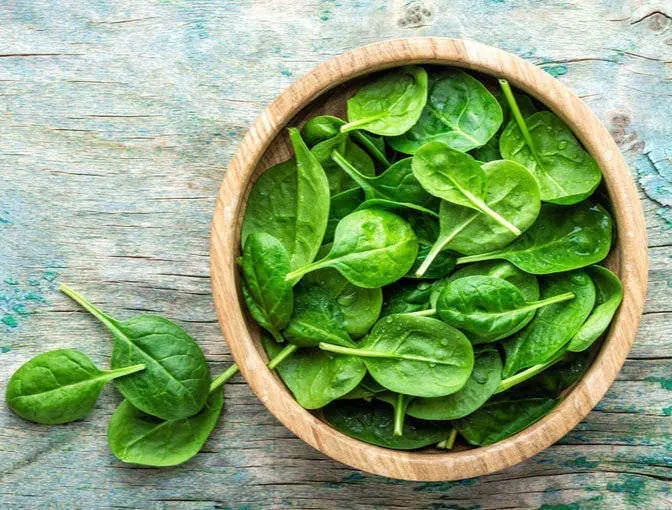
Spinach is naturally a low-fat, low-sugar food that contains high protein and fiber content. This makes it a popular choice for weight loss due to its satiety properties.
You’ll enjoy the benefits of multiple vitamins and minerals in spinach, including calcium, iron, potassium, magnesium, zinc, vitamin A, C, E, and K.
Believe it or not, 1 cup of spinach offers 105% DV of vitamin A and 740% DV of vitamin K.
Recipes:
- Spinach salad with creamy avocado dressing
- Lentil salad with beets and spinach recipe
- Tomato spinach chicken spaghetti
Note: It’s rare for Americans to experience vitamin K deficiency, however too many vitamin K supplements can lead to toxicity.
4. Green Peas
1 cup (160g) boiled green peas contains:
- Calories: 134
- Protein: 8.6g (17% DV)
- Carbohydrates: 25g (8% DV)
- Fiber: 8.8g (35% DV)
- Sugars: 9.5g (19% DV)
- Fat: 0.5g (1% DV)
- Sodium: 239mg (10% DV)
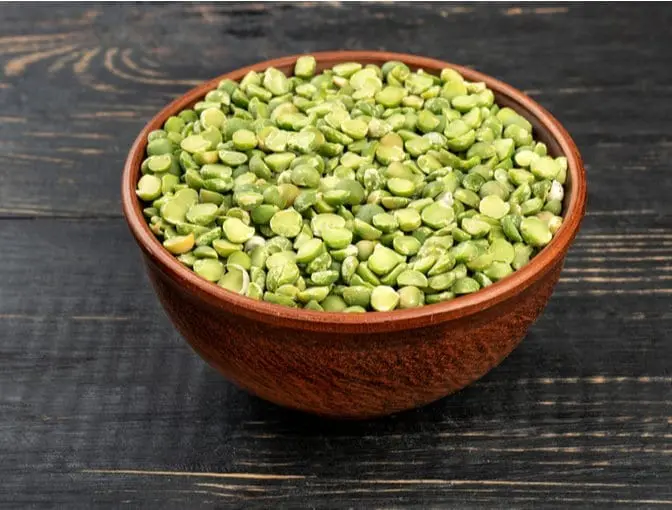
Green peas are one of the best high-protein vegetables with a ton of fiber, which is a big reason why they are so filling.
One of the green peas’ benefits, low glycemic index (GI) — a measure of how quickly your blood sugar rises after meals — is shown to help in regulating blood sugar levels.
So, if you have hyperglycemia or diabetes, green peas can help smooth out blood sugar levels.
Recipes:
- Crunchy roasted green peas recipe
- Slow-cooker parmesan & pea farro with fennel salad
- Pea, feta & summer herb frittata recipe
5. Asparagus
1 cup (180g) of boiled asparagus holds:
- Calories: 32
- Protein: 5.3g (11% DV)
- Carbohydrates: 3.5g (1% DV)
- Fiber: 2.9g (12% DV)
- Sugars: 0.6g (1% DV)
- Fat: 0.8g (1% DV)
- Sodium: 5.4mg (0% DV)

Asparagus may make your pee smell funny, but asparagus is packed with vitamins and minerals such as vitamins A, C, E, K, and B6, folate, iron, copper, calcium, and protein. Plus, it’s a rich source of antioxidants.
Thanks to its high fiber and protein content, it can help you meet your weight-loss goals. Not only that, purple asparagus is full of antioxidants that can help your body fight free radicals that can damage cells.
Recipes:
- Chicken & chive spring salad with asparagus
- Stuffed portobello mushroom recipe
- Creamy celery and asparagus soup
Note: Try not to overcook or undercook asparagus. Overcooking can lower its nutrient content.
6. Edamame
1 cup (172g) of boiled edamame has:
- Calories: 296
- Protein: 31.3g (63% DV)
- Carbohydrates: 14.4g (5% DV)
- Fiber: 10.3g (41% DV)
- Sugars: 5.2g (10% DV)
- Fat: 15.4g (24% DV)
- Sodium: 1.7mg (0% DV)

Edamame beans are immature soybeans that have gained popularity as snacks and appetizers in western countries.
They are naturally gluten-free, cholesterol-free, low in calories, and rich in fiber, protein, iron, and calcium.
The soy protein and soy isoflavones content in edamame has properties to lower the bad cholesterol and raise the good cholesterol in your blood. Isoflavones also seem to be protective against cancer, heart disease, and osteoporosis.
Recipes:
- Edamame hummus recipe
- Spicy garlic edamame might be my favorite healthy snack ever
- Edamame falafel sandwiches
Note: The best way to cook edamame is to boil it for 2-3 minutes with boiling water. Shell it and eat it as a snack or a side dish.
7. Tempeh
100g of cooked tempeh contains:
- Calories: 195
- Protein: 19.9g (40% DV)
- Carbohydrates: 7.6g (3% DV)
- Fat: 11.4g (18% DV)
- Sodium: 14mg (1% DV)
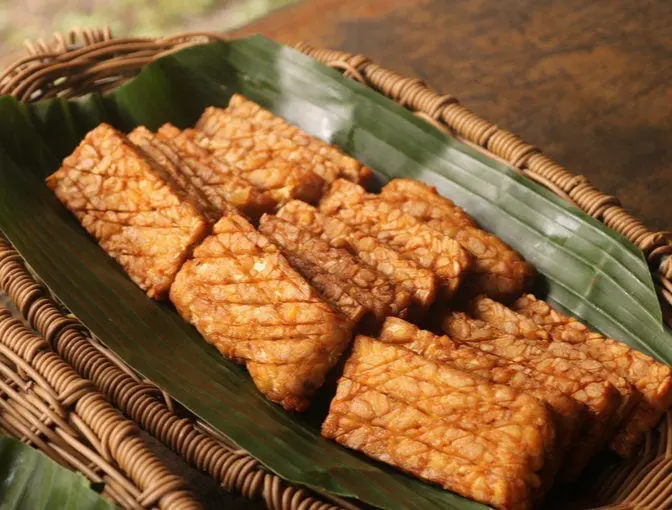
Once popular among vegans and vegetarians only, tempeh has become a popular food choice across the globe thanks to its delicious flavor, versatility, and impressive nutrient profile.
In fact, it tops the ranks as one of the best veggies high in protein, right beside beans, lentils, and natto.
Tempeh is a fermented soybean product from Indonesia that is known to increase bone density, reduce cholesterol, promote muscle recovery and decrease menopausal symptoms.
Interestingly, tempeh is also great for weight loss.
Recipes:
- Vegan savory oatmeal with tempeh bacon
- Cooking with tempeh: Zucchini noodle ramen
- Vegan bolognese with tempeh
8. Tofu
½ cup (126g) of raw, firm tofu holds:
- Calories: 181
- Protein: 21.8g (44% DV)
- Carbohydrates: 3.5g (1% DV)
- Fiber: 2.9g (12% DV)
- Fat: 11g (17% DV)
- Sodium: 17.6mg (1% DV)
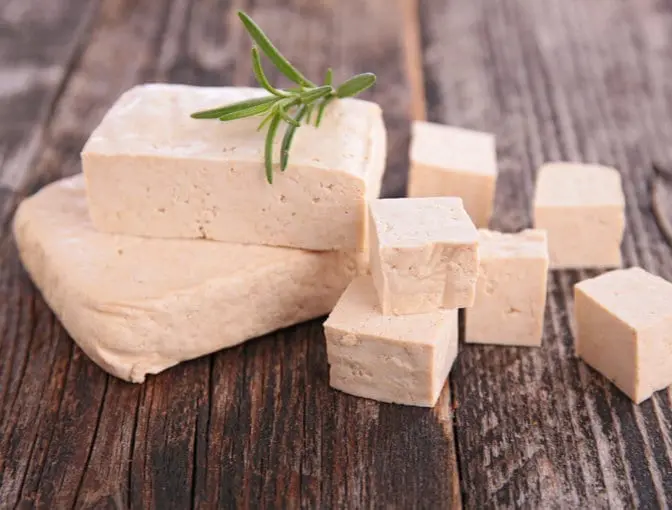
Tofu is the face of protein, alongside legumes. Originally from China, tofu became widespread and sold in most supermarkets around the world.
Tofu is not only a good source of protein, but it also offers complete protein — meaning it contains all nine essential amino acids.
It is also one of the valuable plant protein sources rich in calcium, manganese, magnesium, iron, zinc, and phosphorus.
What’s surprising is tofu’s calcium content. Half a cup of tofu contains 860.6mg of calcium, which makes up 66% of calcium’s daily value.
That’s 8 times more than calcium in 100g of full-fat milk.
Recipes:
- Sweet and sticky tofu with baby bok choy
- Tofu stir fry | simple, fast, and healthy recipe
- BBQ smoked tofu sandwich with toasted almonds
9. Black Beans
1 cup (172g) of boiled black beans contains:
- Calories: 227
- Protein: 15.2g (30% DV)
- Carbohydrates: 40.8g (14% DV)
- Fiber: 15g (60% DV)
- Sugars: 0.6g (1% DV)
- Fat: 0.9g (1% DV)
- Sodium: 1.7mg (0% DV)
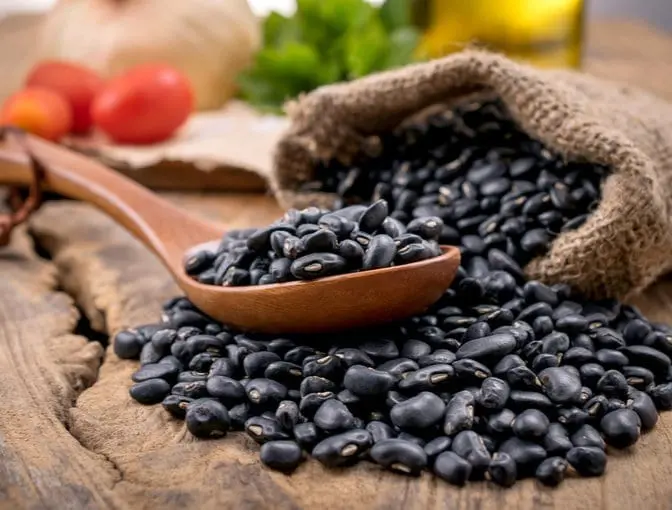
Black beans are one of the best high protein vegetables. They are cheaper than chicken, beef or fish, and yet they’re loaded with fiber, potassium, folate, and protein.
Not only black beans make you feel full longer, but it also helps improve our digestive health and improve the glycemic level in people with diabetes.
These beans are versatile foods that can be cooked with all kinds of foods in any way.
Note: It’s best to eat iron-rich foods such as black beans with foods packed with vitamin C, like citrus fruits and tomatoes because vitamin C helps increase iron absorption.
Recipes:
10. Artichoke
1 cup (168g) of boiled artichoke contains:
- Calories: 76
- Protein: 5.2g (10% DV)
- Carbohydrates: 15.4g (5% DV)
- Fiber: 7.7g (31% DV)
- Sugars: 1.4g (3% DV)
- Fat: 0.8g (1% DV)
- Sodium: 89mg (4% DV)
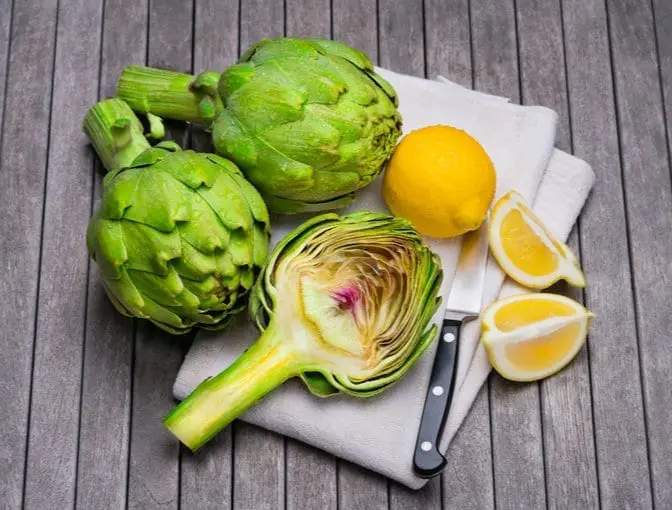
Artichoke is a native to the Mediterranean region, an area with one of the lowest chronic disease rates and highest life expectancy.
Do you know that artichoke is an antioxidant powerhouse?
New studies are pointing at artichokes as the number one vegetable in the antioxidant count, alongside beans.
Recipes:
- Creamy artichoke soup with crisped prosciutto recipe
- Creamy sundried tomato & artichoke chicken
- Artichoke stuffed mushroom caps
11. Fava Beans
1 cup (170g) of cooked fava beans has:
- Calories: 187
- Protein: 5.2g (10% of Daily Value, DV)
- Carbohydrates: 33.4g (11% of DV)
- Fiber: 9.2g (37% of DV)
- Sugars: 3.1g (6% of DV)
- Fat: 0.7g (1% of DV)
- Sodium: 409.7mg (17% of DV)

More well known as broad beans, fava beans are one of the high protein vegetables, it’s loaded with nutrients and they’re free of saturated fats and cholesterol. It also contains high amounts of thiamin, vitamin K and B6, magnesium, copper, selenium, zinc, and potassium.
The high folate content in fava beans is useful for boosting metabolism and supporting the nervous system and healthy red blood cells.
Recipes:
- Fava bean and mushroom crostini recipe
- Fava beans with garlic and lemon
- Roast chicken with fava beans
12. Kale
1 cup (130g) of cooked kale contains,
- Calories: 39
- Protein: 3.7g (7% DV)
- Carbohydrates: 6.8g (2% DV)
- Fiber: 2.6g (10% DV)
- Sugars: 1.7g (3% DV)
- Fat: 0.6g (1% DV)
- Sodium: 19.5mg (1% DV)

Though kale might taste bitter and not on everyone’s favorite food list, it is definitely our bodies’ favorite food.
Because kale is one of the most nutrient-dense foods on the planet.
Kale is packed with vitamins like A, K, C, and B6, as well as manganese, calcium, copper, potassium, and magnesium.
Like other leafy greens, kale has a very high antioxidant concentration, including beta-carotene, vitamin C, and various flavonoids and polyphenols — compounds found in plants that are responsible for health-boosting properties.
Recipes:
13. Okra
1 cup (160g) of cooked okra holds:
- Calories: 35
- Protein: 3.7g (7% DV)
- Carbohydrates: 7.2g (2% DV)
- Fiber: 4g (16% DV)
- Sugars: 3.8g (8% DV)
- Fat: 0.3g (1% DV)
- Sodium: 9.6mg (0% DV)
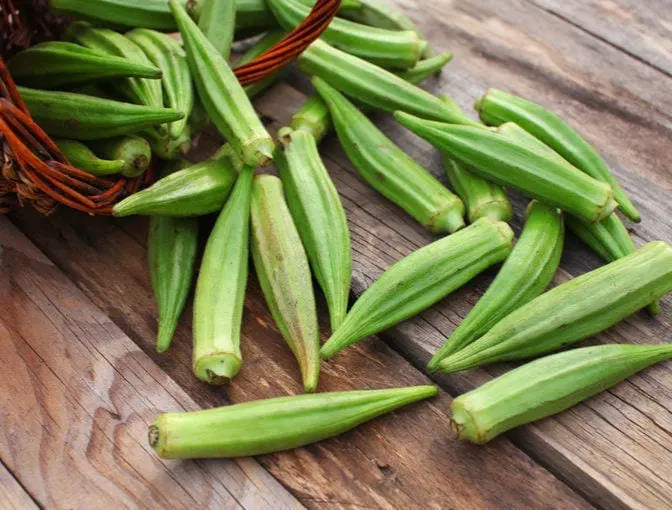
With many different names across the world, okra is also known as lady’s finger or gumbo depending on where you’re from.
Okra may be one of the most overlooked vegetables.
Lectin in okra has been lab-tested to reduce breast cancer cell growth by 63% and killed 72% of human cancer cells.
Here’s another plus point: one of the nutrients in okra, folate, is important in preventing fetal problems during pregnancy.
Recipes:
- Field peas, corn, and okra in country-ham cream
- Easy baked okra
- Heirloom tomatoes and charred okra, vidalias, and malt mayo
Which Vegetables Have More Protein Than Meat?
You may have heard some high-protein vegetables have more protein than meat, but we have to break the news to you.
Protein-wise, vegetables alone have less protein than meat.
But protein-rich vegetables have a better nutritional package than meat.
Science has shown us, studies upon studies, that plant-based foods can reduce the risk of heart disease, obesity, diabetes, some cancers, metabolic syndrome, depression, and better mental and physical function in older people.
People who eat red meat regularly, on the other hand, are at an increased risk of death from heart disease, stroke, and diabetes.
This is not about eating the most protein from a single food.
This is about getting the right protein in small, regular intervals.
The Bottom Line
Look, we’re not asking you to go cold turkey and become a vegetarian or a vegan. But it is important to increase your intake of vegetables and reduce low-quality meat intake.
The kind of meat healthy for you is lean protein meat that has very low fat and is high in protein.
The key here is to be more mindful of what you eat.
The food industry has marketed to us what’s unhealthy as healthy — grand lies to generate more profits.
It is our responsibility to break the hypnosis and consciously choose the foods that serve our health best.
